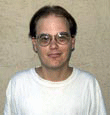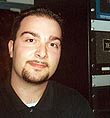|
|
This topic comprises 3 pages: 1 2 3
|
|
Author
|
Topic: Audible effect of high SRD error rate?
|
|
|
|
|
|
|
|
|
|
|
Ray Derrick
Master Film Handler

Posts: 310
From: Sydney, Australia
Registered: Sep 2001
|
 posted 02-16-2002 04:01 PM
posted 02-16-2002 04:01 PM




How many block errors can be tolerated before you take the rather drastic and far more audible step of reverting to analog would have been a software design consideration for the Dolby engineers. It is likely that they did not regard a rate of block errors below a certain level as bad enough to warrant reversion.Has anyone noticed if this problem is software version related? If it is only on say, later versions, there is always the possibility that it is a bug and Dolby don't know about it. It is also very important for projectors to run as close as possible to correct speed because, unlike the optical soundtrack which just shifts up or down in pitch, a digital system is designed around a constant data rate and so must use some method such as software "splicing" to correct for the speed difference. This can cause audible artefacts if the speed variation is too great. ------------------
Ray Derrick
President/Chief Engineer
Panalogic Corporation Sydney, Australia
Phone: 61 (0)2 9894 6655 Fax: 61 (0)2 9894 6935
| IP: Logged
|
|
|
|
|
|
|
|
Ken Jacquart
Film Handler
Posts: 82
From: San Francisco, CA, USA
Registered: Mar 2000
|
 posted 02-17-2002 12:55 AM
posted 02-17-2002 12:55 AM





What you guys are hearing are "block repeats". If a Dolby Digital block cannot be read, even after all error detection/correction, then the previous block will be repeated in its place. A Dolby Digital block occurs every 1/96 per second (or every 10 ms). A repeated block will consume 10 ms of time and can barely be heard if you are paying attention to it. If two blocks are repeated in a row, then it is a little bit easier to discern (albeit very slight). If the processor cannot read 3 blocks in a row, it will revert to SR (3 strikes and you're out!). So, whenever you see that brief "F" on the Cat 673 card, you will hear a block repeat (or two). If this occurs on a regular basis, then you probably have a problem with alignment... namely, most likely, video amplitude. Drag out the scope and check it... good ears on those block repeats! ken
| IP: Logged
|
|
Steve Guttag
We forgot the crackers Gromit!!!

Posts: 12814
From: Annapolis, MD
Registered: Dec 1999
|
 posted 02-17-2002 01:49 AM
posted 02-17-2002 01:49 AM




Like everything else in software, it seems that there is always a senerio that beats the system...I once had a bad reader/print situation (a penthouse reader at that!!!) where the block repeat was just enough to be annoying yet not enough to have the DA-10 drop to analog. So it sounded like one was virtually under water for the last reel of Harry Potter. Using DRAS...looking at r-9 the azimuth jumped from say -1 to about -8 and stayed there! One reader did ok with it, the other, did not! I've recently taken a liking to the skinny splicing tape either 16mm or 19mm...no drops and no seemingly ill affect regarding print longevity. Steve
| IP: Logged
|
|
|
|
|
|
|
|
|
|
|
|
All times are Central (GMT -6:00)
|
This topic comprises 3 pages: 1 2 3
|
Powered by Infopop Corporation
UBB.classicTM
6.3.1.2
The Film-Tech Forums are designed for various members related to the cinema industry to express their opinions, viewpoints and testimonials on various products, services and events based upon speculation, personal knowledge and factual information through use, therefore all views represented here allow no liability upon the publishers of this web site and the owners of said views assume no liability for any ill will resulting from these postings. The posts made here are for educational as well as entertainment purposes and as such anyone viewing this portion of the website must accept these views as statements of the author of that opinion
and agrees to release the authors from any and all liability.
|

 Home
Home
 Products
Products
 Store
Store
 Forum
Forum
 Warehouse
Warehouse
 Contact Us
Contact Us




 Printer-friendly view of this topic
Printer-friendly view of this topic

















